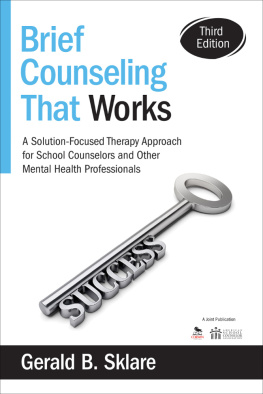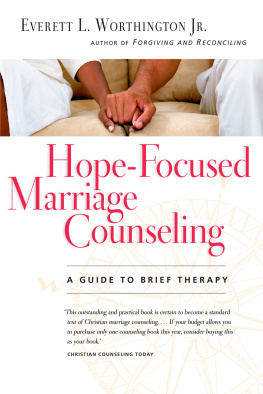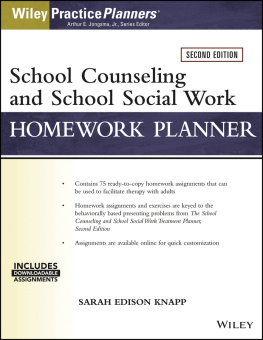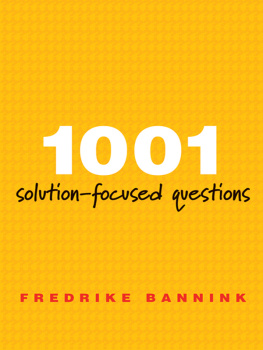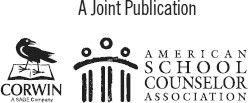This book provides step-by-step instruction in how to use solution-focused brief counseling (SFBC) with youth. School counselors certainly will be able to relate to the typical client concerns presented. Teachers will also benefit, because each component of this approach can be used independently in a variety of situations and school settings. Other professionalspsychologists, social workers, marriage and family counselors, pastoral counselors, licensed professional counselors, and drug counselors who work with youthalso will find the methods and case studies relevant.
SFBC is ideally suited for schools and mental health facilities. With large caseloads, school counselors and other mental health practitioners often have too little time to provide clients with longer-term, traditional counseling. Today more than ever, mental health professionals need a brief but effective approach suitable for a wide range of problems.
The book is intentionally short. Theory and research are discussed briefly; however, implementation is the main thrust. My approach is to lead you through the material one step at a time, including practice exercises at the end of the first four chapters and in Appendices A and B. I seek to provide the knowledge necessary to apply SFBC with children and youth.
Overview of the Contents
The book is based on the work of Steve de Shazer (1985), who developed the SFBC approach. He discovered that by focusing on solutions rather than problems, clients were getting better faster than with traditional counseling modalities. Implicit in the model is the belief that clients are not always overcome by their problems. In fact, solutions are present even though they may be unrecognized. By rediscovering their resources, clients are encouraged to repeat past successes. As simple as this sounds, it represents a powerful, empowering dynamic that enables clients to quickly resolve the difficulties that brought them to counseling.
presents background, research, rationale, and principles for SFBC. The chapter also highlights the reasons SFBC techniques work well with clients from various cultural backgrounds. The exercise at the end of the chapter guides you to experience firsthand the effects of problem-oriented questions versus solution-oriented questions.
demonstrates how to introduce clients to solution-focused counseling and how to facilitate the initial goal-setting phase of the model. Step-by-step procedures prepare you to help clients identify, behaviorally, what they will be doing to achieve their goal. In the section on the miracle question, you learn how to help clients explore their goal by painting a mental picture of what their lives would look like if they were problem free. The exercises at the end of the chapter provide practice with goal setting and an opportunity for you to experience how the miracle question can help you with a problem youd like to overcome.
describes how you can equip clients to identify instances of unrecognized success and exceptions to their difficulties. You learn how to encourage clients through cheerleading that reinforces even slightly successful steps clients have used to improve their situation. This chapter also covers scaling techniques clients can use to assess their current status as well as progress toward their goal. The chapter concludes with detailed instructions for constructing a messagecomposed of compliments, a bridging statement, and taskthat clients receive at the end of each interview. A practice exercise gives you a chance to apply these steps in addressing a personal situation of your own.
.
describes how to conduct an abbreviated SFBC counseling session and provides a flow chart and note sheet to help you implement the process. This short format is ideal when counselors and mental health practitioners may only have time for a 20- to 25-minute session with a client.
covers the interventions you use in second and subsequent sessions to address the successes and challenges clients have experienced since the previous meeting. The chapter also discusses the scaling interventions used during second and subsequent sessions to determine clients progress, and the use of a message to reinforce behaviors that keep clients on track for reaching their goal.
addresses ways you can help reluctant and mandated clients become cooperative customers for counseling. The chapter also provides suggestions for dealing with particularly challenging situations and details techniques for turning difficult situations into workable goals.
describes eight other applications of the solution-focused approach. It discusses 10-second "counseling," the use of a solution-focused referral form, and how to implement the solution-focused approach using puppets and using sand trays. The chapter also details how solution-focused concepts and techniques have been applied with small groups, entire classes, parentteacher conferences, and guided imagery for groups.
contains detailed instructions as well as pages that can be enlarged and duplicated to create the booklet participants use in the solution-focused guided imagery group activity.
Whats New in This Edition
Since the second edition of this book in 2005, many exciting developments have made even clearer the value of staying focused on solutions. In particular, this new edition cites recent research on the effectiveness of solution-focused counseling and therapy, highlights more applications and new adaptations of SFBC, and provides new tools to help the practitioner.

